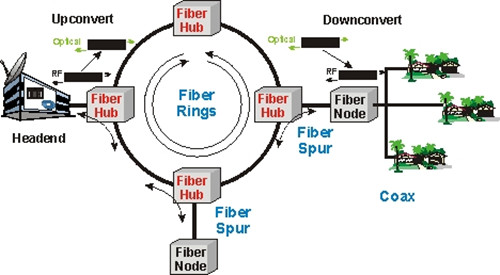As cable and telecommunication operators are striving to introduce new services to meet the surge in data demand, they must find a plan that evolves their current networks and maximize their full capacity. HFC, as an upgraded community antenna television (CATV) network, might be a great news for them. The purpose of this article is to present a brief introduction to HFC network.
In order to have a better understanding of HFC, let’s first get familiar with CATV network. CATV refers to a system of transmitting television signals to subscribers, using radio frequency (RF) signals transmitted through coaxial cable. But 1980s witnessed a breakthrough in cable television network that CATV can be transmitted through optical fiber.
Definition of HFC
HFC refers to a broadband telecommunication network that combines optical fiber and coaxial cable, which has been utilized globally by cable television operators since the early 1990s. HFC is also called the 2nd generation of CATV systems that use fiber optic cable for the headend and feeder distribution system and coax for the customers end connection. HFC system is mainly used for delivering video, telephony, voice telephony, data and other interactive services over coaxial and fiber optic cables.
HFC refers to a broadband telecommunication network that combines optical fiber and coaxial cable, which has been utilized globally by cable television operators since the early 1990s. HFC is also called the 2nd generation of CATV systems that use fiber optic cable for the headend and feeder distribution system and coax for the customers end connection. HFC system is mainly used for delivering video, telephony, voice telephony, data and other interactive services over coaxial and fiber optic cables.
In a HFC system, the fiber optic network extends from the cable operators’ master headend, then out to a neighborhood’s fiber hub, and finally to a coaxial fiber node which serves anywhere from 25 to 2000 homes.

The above image shows HFC distribution system. Firstly, multiple RF television channels at the headend are shifted in frequency to allow distribution through high-speed fiber cable. The fiber cables are connected in a loop around the cable television service area. In this way, if any break occurs in the cable, the signal will automatically be available from the other part of the loop. The loop is tapped at regular points by a fiber hub that can distribute the optical signals on fiber spurs. At last, the fiber spurs end into fiber nodes that translate the signal from a light beam to an electrical signal, and send it over coaxial cable lines for distribution to subscriber residences.
Advantages of HFC Network
To begin with, HFC network provides high performance at low cost because they can be designed to match the asymmetrical bandwidth needs of most broadband distribution systems. In addition, it needs less maintenance costs due to fewer amplifiers required and also less electricity than coaxial.
To begin with, HFC network provides high performance at low cost because they can be designed to match the asymmetrical bandwidth needs of most broadband distribution systems. In addition, it needs less maintenance costs due to fewer amplifiers required and also less electricity than coaxial.
In addition, the most obvious advantage of HFC is that there is no need for subscribers to change the already existing coaxial networks as it uses a separate connection. It also has the ability to adapt to new services such as voice, data or video without changing existing operational parameters. Compared to CATV, HFC network is more reliable, immune to noise and has almost non-existent attenuation.
What’s more, HFC network possesses a high bandwidth capabilities. It increases from traditional CATV network (up to 330 MHz or 450 MHz) to 750 MHz (It can be upgraded to 1 GHz in the future) with HFC. This new generation cable network is now used for cable telephones, increased number of CATV channels (over 200) and a direct infrastructure to new digital TV standard.
This passage has made a brief introduction to HFC network. I hope readers can learn from it. Fiberstore supplies a variety of optical communication products including HFC optical transmitter, HFC optical receivers, FTTH optical transmitter, FTTH optical receivers, SAT-IF optical transmitter & receiver, EOC system products, and optical switches, etc.They are striving to provide the best services to all the customers.
Originally published at www.fiber-optic-solutions.com/hybrid-fiber-coax-hfc-access-network.html
评论
发表评论